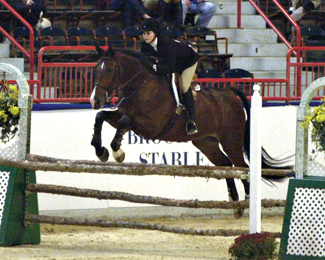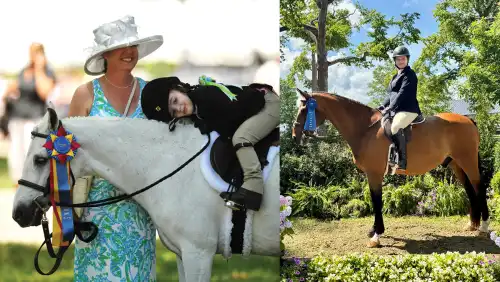She ends a stellar year in the equitation with a big win.
Tina DiLandri finished off an amazing year at the Los Angeles National.
DiLandri has been making her mark in the equitation ring—winning the Region 8 Maclay, placing second in the Tad Coffin Washington International Equitation Classic Finals (D.C.), third in the Pessoa/USEF Medal Finals (Pa.), and second in the USEF Show Jumping Talent Search-West (Calif.). She capped it all with a win in the West Coast Equestrians Junior/Amateur Medal Finals at the L.A. National, Nov. 14-18 in Los Angeles, Calif.
 The WCE Medal is the only advanced level medal class where juniors and amateurs compete together. The WCE is a jumper-style equitation class where jumping faults and time penalties play a big role.
The WCE Medal is the only advanced level medal class where juniors and amateurs compete together. The WCE is a jumper-style equitation class where jumping faults and time penalties play a big role.
“The WCE is like the jumper phase of the Washington [International] because of the time and faults. You have to be very precise,” explained DiLandri.
The first round of the finals is a power-and-speed phase. Regardless of jumping faults that may be incurred in the power phase, all riders jump the entire course and receive an equitation score less any time faults or rails down.
The second round is a Table II-style course set at 375 meters per minute. For many riders, riding at the pace required and still being smooth and stylish proved challenging.
For DiLandri, it was no problem. The final round for the top 15 riders is held over a jump-off course. DiLandri, who had the highest score so far, went last in the order.
“When I saw Zazou [Hoffman] put in a good trip and go for it, I knew I had to. No guts, no glory!” said DiLandri. “I didn’t know if my horse could go fast, but he stepped it up.”
| Tidbits
• It wasn’t all about equitation at the L.A. National. Junior and amateur-owner jumper riders also have a year-end championship that features a three-phase competition. Amateur Holly Scapa rode to victory with her new grand prix prospect, Country Girl. Scapa found the talented mare in Europe and hopes to step into some grand prix classes in 2008. Scapa is an experienced amateur-owner rider and has some grand prix experience as well. Paige Dotson was reserve champion aboard Friponnier II. • Andrea Downs watched her lovely gray gelding, Night Cap, win the pre-green hunter championship with Nick Haness in the irons. A year ago, Downs lost her horse to an unfortunate accident. Finally this past spring she went to Europe with a friend to look for a new horse. ADVERTISEMENT“We went to this ‘hole in the wall’ place and saw this amazing horse. I said, ‘That’s the one!’ when I saw him jump. He jumped every jump the same and I wanted a pretty horse,” Downs said. At first, trainer John Bragg was concerned when Downs approached him about training her horse, a horse she selected without the assistance of a professional. “He is a beautiful type, jumps well, and is nicely balanced,” Bragg said. “He is going to have a great career, and Annie has been very patient.” Following Bragg’s advice, she has left the riding to the professionals, but as the gelding starts in the first year greens in 2008, Downs will begin showing in the adult amateur hunters. |
“We loved her,” said Chrystine Tauber, who judged with Timmy Kees. “Tina was outstanding from start to finish. She showed us finesse, speed, turns, and did it all beautifully. She showed us that she understood what was being asked in all three phases of the class.”
“She showed a ‘certain something’ and a great feel,” added Kees.
The top finishers in the WCE Finals all have strong jumper experience, including DiLandri. She won the Show Jumping Hall of Fame Junior Jumper Western League with Chanel 292.
“The jumpers have been hard for me,” stated DiLandri. “I really feel I am more naturally a hunter type rider. I have to really work at the jumpers, and it is hard for me to transition back and forth.”
DiLandri only started in the high junior jumpers during the HITS Desert Circuit (Calif.) in 2007. She struggled through some low spots at different points in the year but always fought her way out.
“[My trainer] Karen Healey is great. She knows my goals and gives 120 percent to match my efforts. I really feel like I skyrocketed this year,” said DiLandri, who has her eye on the grand prix ring. “I took my first riding lesson from Gretchen Tank when I was 5 years old. The first week I started to ride I told everyone that I wanted to be in the jumping ring in a week.”
DiLandri met that goal and has never looked back, although she is quick to credit those who gave her such a strong foundation and love of the sport. “I spent years with Becky Warner in Arizona and she got me started in the equitation,” she said.
In 2006 it was time for DiLandri to challenge herself further and compete at the bigger shows, like those throughout Southern California. Karen Healey was her choice for a coach, and DiLandri willingly commutes between Arizona to ride and show.
Although she rides in the 12 and under equitation, Corinne Miller is as focused and passionate as DiLandri. After several successful years showing ponies, including trips to indoors and the USEF Pony Finals, trainer Mark Bone told Miller it was time to move to a horse. Miller easily qualified for the Onondarka Medal Finals, which is about as important to the 12 and under set as the World Cup Finals is to grand prix riders.
ADVERTISEMENT
Scott Starnes sets courses with a similar level of difficulty as the Medal and the Maclay finals, only at 3′. Miller, in her first time riding in the Onondarka Finals, rode with poise that belied her years. “She was bloody consistent,” said Kees.
“She rides with a plan, confidence, and a sense of timing,” added Tauber. “She was solid every time she stepped in the ring,” said Kees. “This is the best class in the country for 12 and under riders.”
Eight riders returned for the work-off, and Miller led the field. “We incorporated a lot of flatwork into the work-off since they had jumped so much,” said Tauber. Throughout the test riders had to lengthen the trot, turn on the forehand, and counter canter.
Miller’s own horse got hurt before the finals, so they leased Vriendle from Laura Santana. “I was just hoping to do well,” said Miller. “After I won the first two rounds I was a little bit nervous [about the third round], but I had fun.”
In the work-off, Miller had a little trouble with Vriendle in the turn on the forehand, but she stuck with it and executed the test. “We looked at the problems the riders had to see how they coped and the correct use of aids,” Tauber said. Miller clearly showed her understanding of the turn on the forehand despite her horse’s fussiness.
A National Onondarka Finals?
Chrystine Tauber, who enjoyed a successful international career and serves at the Vice President of the U.S. Hunter Jumper Association was so impressed with the Onondarka Finals after judging them that she mused, “Why don’t we have this class nationally?”
California’s 12 and under riders prepare all year for the prestigious Onondarka Finals, and the perpetual trophy is a roll call of famous riders, including Susie Hutchison, Lise Quintero, and Francie Steinwedell-Carvin.
“I wish we had something comparable [nationally],” said Timmy Kees, who judged alongside Tauber.
California is well known for its depth of equitation riders, who result not just from excellent coaching but a plethora of quality medal programs that begin at the 2’6″ level and go up to the Medal, Maclay, and Talent Search. Regularly West Coast riders, like Tina Dilandri, earn top spots in the national equitation championships, and it is rare that a West Coast rider did not start in the Onondarka.
Langer Equestrian Group President Larry Langer, who hosts the Onondarka Finals at the Los Angeles National, said that he would speak with Don Simmington, whose family started the Onondarka Riding Club and the subsequent Onondarka Finals, if the USHJA approached him about a national component for the Onondarka Medal.
Marnye Langer














